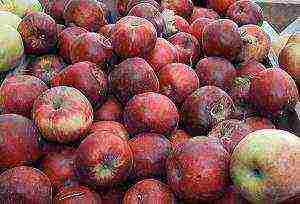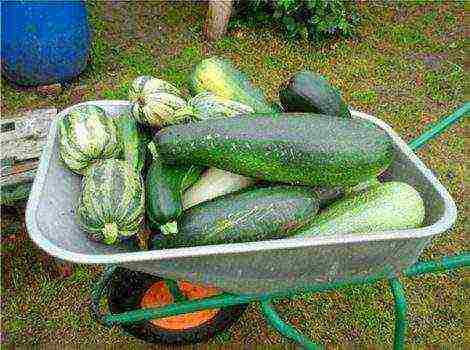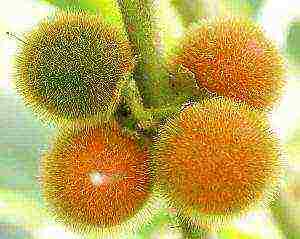Content [show]
Patisson is a plant of the Pumpkin family, which has a decorative rounded shape in the form of a plate, therefore, sometimes this vegetable is called a dish-shaped pumpkin. But still, the word "squash" comes from the French pâté (pie), because the fruits of the plant really resemble a beautifully designed dessert or pie. In terms of quality and taste, the fruits resemble zucchini, they are fried, boiled, salted and pickled.
The homeland of the squash is South America, from where it was brought by seafarers and discoverers of two continents in the 17th century. Currently, the vegetable is grown in almost all European countries, including Russia.
Based on the species that were once brought to the Old World, breeders managed to develop a lot of new varieties, with fruits of various colors, it can be white, green, yellow, with or without stripes and spots. Outwardly, the plant looks like bush zucchini, but there are also weaving forms among them.
A flowering bush of squash is easy to mistake for bush squash:
Squash varieties differ in terms of ripening, just like all other vegetables, they can be early, medium or late. But at the same time, all varieties of squash are useful for humans, therefore they are used with pleasure in cooking and even in folk medicine, which takes into account the healing properties of seeds and vegetable juice. The most useful substance for a person in the composition of squash is lutein, which has a beneficial effect on human vision.
Choosing the right variety
Growing squash in your garden is not at all difficult. As you know, all plants of the Pumpkin family grow quickly and without problems, without requiring special attention. In order for fresh squash to be on the table all summer, and so that they are enough for harvesting for the winter, you can plant several varieties, different in ripening time. What to opt for?
Early maturing varieties
Bingo bongo
Bingo Bongo ripens very early, 40 days after germination. The form of the plant is bushy, compact, does not take up much space on the site. It stands out from a number of congeners with violet-green fruits shaped like discs with wavy edges. The flowering pulp is white, the taste is delicate, the structure is tender and juicy. Fruit weight - 500-600 grams. The fruits can be preserved and used for stewing and frying.
Bingo bongo
Gosh
The Gosha variety is early ripe, the first fruits can be harvested 38-42 days after germination. They are not very large, weighing 300-350 grams, their peel is dark green, and the flesh is white with a yellow tint. The variety is excellent for conservation, due to which the quality of the fruit is preserved for a long time.Gosha grows in the form of a bush, its flowers and leaves are just like those of zucchini. It bears fruit for more than a month, and during this time it gives about 5 kg of fruit.
Gosh
Disk
Variety Disk is distinguished by its white color and bell shape. Unripe fruits have a greenish tint, but gradually it disappears, and the fruits become pure white. They ripen quite quickly - 40-42 days after germination. The sizes of the fruits are small - 300-350 grams, small fruits that have not reached their final size can be plucked and rolled into jars as a whole. In this case, the yield of the bush will be low, but this deficiency will be compensated for by the taste and quality of canned squash, which will be eaten first.
Disk
Umbrella
The Umbrella variety is early maturing, the first harvest is harvested 45-55 days after germination. Fruit weight is about 400 grams, yield per bush is 4-5 kg. The fruits are harvested after they reach 8-10 cm in diameter, with poorly developed seeds. In color, the fruits are white-green, or white. They are flat in shape with clearly visible denticles. The taste is wonderful, tender and juicy. Squash are suitable for preservation and preparation of daily meals, but they are not stored fresh for a long time.
Umbrella
UFO Orange
Variety UFO Orange - large, weighing up to 500 grams, orange fruits, with mild wavy edges, will appear 45 days after germination. Their flesh is tender and juicy, white in color. The strong peel of mature squash can be used as a pot for baking vegetables in the oven and for stuffing. For stewing and preservation, fruits are used that have not reached technical maturity, with soft peel and pulp. The productivity of the bush is high, during fruiting it gives up to 15 kg of fruit.
UFO Orange
Polo F1
The Polo F1 variety is early maturing, growing in the form of a compact bush. Unripe fruits are light green, when mature they become pure white. Weight 300-400 grams. The variety attracts with a high and stable yield, which can be 10-15 kg per season, and disease resistance. The fruits are good both fresh and canned.
Polo F1
Sunny bunny
The Sunny Bunny variety is early, the fruits are harvested 40-42 days after germination. Their color is golden yellow, sunny, the flesh is white, with a slight yellow tint. The weight is small - about 200 grams, suitable for seaming, and for cooking stews and fried dishes. The Sun Bunny grows as a compact bush, during the period of active fruiting, it is literally strewn with golden squash plates, and can produce up to 15 kg of fruit per season. The variety is unpretentious, resistant to typical problems.
Sunny bunny
Cheburashka
The Cheburashka variety is super early, the first fruits ripen in 35-40 days. A variety of Russian selection, therefore it tolerates cold and other unpleasant features of the continental climate well. The bush is climbing, but the whips are short - about 1 meter. The fruits weigh 250-400 grams and are plate-shaped with wavy edges. The color is white outside and inside. The pulp is tasty, juicy. Average yield - 4-5 kg per bush.
Cheburashka
Shatrez
The Shatrez variety is early ripening, with medium-sized fruits, the weight of which does not exceed 100-150 grams, and the diameter is no more than 5-6 cm. The peel of mature squash of this variety is dark green, with white or yellowish spots and stripes, the flesh is white, has a good taste. Mini-squash can be preserved without cutting, as a whole.
Shatrez
Mid-season varieties
Mini crumb
The Mini crumb variety gives small fruits, they are put whole in a seaming jar. Their diameter is only 3-5 cm, weight is about 70 grams, taste like ordinary large squash. The variety is grown according to the usual technology, without making allowances for the small size of the fruit. Mini crumb grows in the form of a bush, and the fruits and leaves are small in the variety. Harvested 50 days after germination, fruiting lasts several weeks, during which 3-5 kg of squash are plucked from the bush.The mini Solnechny blast variety, which appeared on the Russian market relatively recently, is distinguished by similar qualities.
Mini crumb
Watermelon
It is not in vain that the Arbuzinka variety received such a name. In shape, this is an ordinary squash with wavy edges, but it has a watermelon skin color and a melon berry flavor. The weight of one "watermelon" is 400-450 grams, fruiting lasts about two months, the yield is high - up to 15 kg per bush. The first fruits appear 50-55 days after germination, they are used for stewing, frying and canning.
Watermelon
Snow White
Variety Snow White - from the name it becomes clear that its fruits are snow-white, with white flesh. Snow White's bush is compact and neat, takes up very little space. The fruits weigh 250-300 grams and have a wonderful taste. The fruits are canned, stewed and fried. Fresh, in the refrigerator, they are stored for about two months.
Snow White
Malachite
The Malachite variety grows as a small shrub. Fruits are malachite-green at first, when ripe they become lighter, have the shape of a disk without strongly pronounced denticles at the edges. The pulp is white, tender, with excellent taste. They are quite large - up to 550 grams, long-term fruiting, therefore, the productivity of the bush is high - up to 16-20 kg per season. The variety has good immunity to diseases and pests. The fruits are used for pickling, stewing and frying.
Malachite
Sun
The Solnyshko variety bears bright yellow fruits weighing up to 300 grams. They ripen in 45-50 days, but they are not kept until technical ripeness, but are plucked unripe. In this form, they are tastier for preservation and for stewing and frying. Small-sized squash becomes an ideal "dish" for baking and stuffing:
Sun
White UFO
The White UFO variety, like most white varieties, has bell-shaped fruits with well-defined wavy edges and a convex top. Their sizes are small - up to 8 cm in diameter, weighing about 100 grams. The rind may not be pure white, but light green, the flesh is white, with a wonderful taste. There are almost no seeds. If you pick them at the moment when their diameter is less than 8 cm, then there will be no seeds at all, and the taste will be even more pleasant. Ripening occurs in 50-55 days.
White UFO
Late varieties
White 13
Variety White 13 - ripens in 60-70 days. It grows in the form of a small bush, occupying an area of 70x70 cm. The variety is thermophilic, gives white or yellowish fruits, light tender pulp. The shape of the fruit is plate-shaped, wavy at the edges. The weight is quite large, up to 500 grams, in general, the yield is 6-7 kg from one bush. The fruits are suitable for canning, stuffing, baking.
White 13
There are not so many late varieties of squash in Russia, and this is not surprising, the plant is thermophilic, and the summer is short here, in August the nights are already cold, which significantly reduces the crop yield. The first fruits have time to form and ripen, however, due to the cold weather, the fruiting period is reduced. Therefore, the main requirement for the late variety is its cold resistance and the ability to form fruits at night temperatures in the range of 10-15 degrees.
Somehow it has already become a tradition that domestic gardeners, who are happy to grow unpretentious zucchini and pumpkins, deprive the attention of squash. Meanwhile, this vegetable has great taste, is very healthy, and is not that difficult to grow. The varieties and types of squash presented below with photos and descriptions will give an idea of this culture, and recommendations for care will allow you to get a good harvest without problems.
Plates, discs and umbrellas
Squash belongs to the large family of pumpkin seeds, is grown everywhere today, although the American continent is considered the homeland of the vegetable. The plant is bushy or semi-bushy (climbing varieties are also found), with a powerful stem and large green leaves.
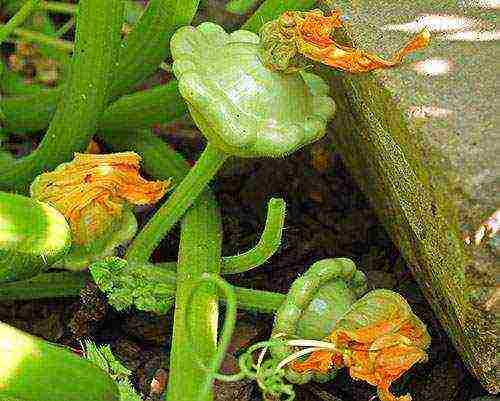
Large flowers have a bright yellow color, they are monoecious and unisexual.Fruits are round, depending on the variety, they can have a plate or bell-shaped shape, smooth edges or with scallops. The color range of pumpkin fruits is diverse, and if earlier everyone knew mostly white squash, nowadays you can grow emerald, orange, yellow, purple fruits in the garden. Available in variegated, striped and spotted varieties.
IMPORTANT!
By its nutritional and taste qualities, squash "overtakes" zucchini.
The pulp of the fruit is distinguished by its high density and good taste. Squash is used for various types of marinades, any preservation is good with them. Also, a wide variety of dishes are prepared from squash, including mashed potatoes, caviar, stews, pancakes. This vegetable is great for preparing stuffed dishes, as well as candied fruits.
ON A NOTE!
Many people note that canned small squash tastes like porcini mushrooms.

Patissons differ not only in color, shape, but also in terms of ripening. For most regions of Russia, varieties and hybrids with early and medium ripening periods are best suited, allowing for faster harvesting. Also on sale are not only varieties, but also hybrids, which are characterized by unpretentiousness, simple care and fairly high yields. It is advisable to plant plants with different periods of fruit ripening on the garden bed in order to get squash throughout the season.
ON A NOTE!
The multi-colored fruits of some varieties of vegetables will become a very original decoration of garden beds.
Gardeners prefer to grow universal varieties, the young of which are suitable for conservation and pickling, and the large ones are processed.
Descriptions of varieties and hybrids of squash
Traditional white
In the review, we decided to make the color gamut of the fruits of this interesting garden crop a criterion for classification. And the review will open a description of white-fruited squash - practically the ancestors of all others.
Snow White
For beginners who are just mastering the agricultural technology of this vegetable, the productive variety Snow White is an excellent choice. This variety is distinguished by early ripening (up to 47 days), a powerful bush. The fruits look like small white discs, there is a slight segmentation, along the edges there are teeth. Weight - no more than 350 grams.
The squash is thin, the flesh is snow-white, crispy and very dense. Baby fruits are great for preservation, pickles, large squash are used in cooking.
White 13
One of the most famous varieties of white-fruited squash. On a powerful, spreading bush, a large number of squash-discs with a whitish-green peel are formed. They appear 55-67 days after the appearance of the first shoots, therefore the plant belongs to mid-season varieties. With good care, up to 4 kg of tasty fruits can be harvested from one square meter.
IMPORTANT!
It is recommended to collect squash when their diameter does not exceed 8 cm. It is during this period that they are especially tasty, later the pulp becomes fibrous.
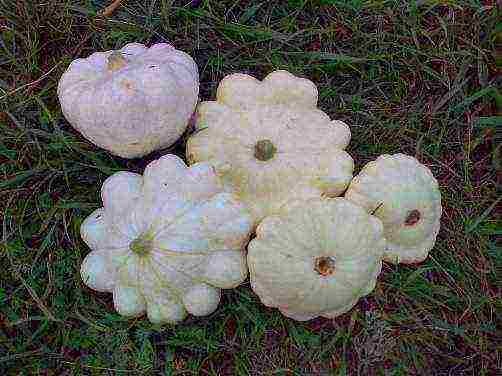
Fruits can weigh up to 500 grams, small squash can be well preserved, larger ones can be used for cooking.
UFO (White)
Fruits of the UFO White variety have excellent taste. Ripening time - up to two months, while the plant is cold-resistant.
The UFO patisson variety is appreciated for its unpretentiousness, productivity. Patissons are large, traditional for culture in the form of a plate, with a skin of white-light green color. The pulp has a dense structure. It is recommended to remove the UFO squash when it has a diameter of no more than 6-8 cm. The weight of overgrown squash can reach 800-1000 grams.
Cheburashka
Another variety that Russian gardeners love is Cheburashka. This is an early ripe squash, which forms fruits already 40 days after the appearance of the first shoots. Its white "saucers" reach a weight of up to 400 grams, have a smooth surface, juicy and very tender flesh.
Patisson Cheburashka is distinguished by a strong, powerful bush, good fruit set, resistance to temperature changes. This variety belongs to those few squash that do not reduce productivity even with small drops in air temperature.

IMPORTANT!
Early squash Cheburashka is recommended for cultivation in regions of risky farming.
The fruits are suitable for all types of processing and conservation.
Umbrella
The review of white-fruited patissons will be incomplete, if you do not mention the productive and unpretentious Umbrella variety. It is included in the group of early-maturing species; it will take only 45 days to wait before harvesting.
Fruits are large, up to 1 kg, with snow-white juicy pulp. The peculiarity of this variety: the sweet taste of the pulp, since the composition contains a high content of sugars. Also, the Umbrella variety is distinguished by long-term fruiting, therefore, with proper and good care, from July to the end of August, ripe umbrella fruits can be harvested.
 A remedy from which plants grow by leaps and bounds! Just water your plants with it ...
A remedy from which plants grow by leaps and bounds! Just water your plants with it ...
Sunny vegetables
In this group, descriptions of squash are offered, which have a yellow or orange color. On the beds, bushes with such fruits look very festive and elegant, and they are not inferior in taste, and some even surpass their "pale-faced" counterparts.
Toddler
The squash from the collection of the agricultural firm "Aelita" under the original name Karapuz became famous for its excellent yield. This novelty has proven itself well among gardeners in different regions.

The bush at the Little Boy is compact in size, the fruits are bright yellow, plate-shaped. The average weight is no more than 500 grams, but for preservation and pickles, it is recommended to use small squash. Toddler fruits can be stored for a long time, they are also suitable for transportation.
UFO (Orange)
Among the early yellow squash, attention should be paid to the UFO Orange variety. Firstly, it ripens early (it takes only 45 days), and secondly, this squash is one of the best varieties for canning. It looks very impressive on the garden bed.
The flattened fruits are disc-shaped, the edge with small wavy scallops. The skin is dense, orange in color, but the juicy pulp is snow-white. The yield of the variety is excellent, and if you follow all the rules of care, then up to 25 fruits weighing 300-400 grams can be removed from one plant.
IMPORTANT!
UFO variety Orange is resistant to low temperatures.
This squash is suitable for all types of preservation, as well as in cooking.
Fouette
The Fuete variety has also proven itself quite well, the weight of the fruits of which reaches an average of 300 grams.
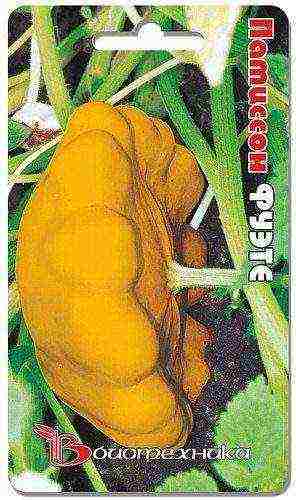
The plant is a bush type, fruit in the form of plates, with a scalloped edge. Patissons have a beautiful yellow color, but their flesh is snow-white, very juicy. The fruits are used for preservation, they are also good for baking.
Sun
A little longer, about 60-70 days, you will have to wait for the harvest of squash from the Solnyshko variety. But on the other hand, these fruits can be stored for a long time after harvesting, while the taste will not be lost.
The Sun has a compact bush, and the fruits reach a mass of 300-350 grams. The color of the squash is yellow, the shape is in the form of a disk with small waves along the edge. The pulp is creamy and firm. All fruits on the bush are even, up to 12-15 squash can be removed from one plant.
This variety is one of the best for preparing original stuffed dishes.
Sunny Bunny F1
If there is a variety Solnyshko, then how not to be a hybrid Sunny Bunny. Refers to early ripening squash, it takes about 45 days until the fruits ripen.
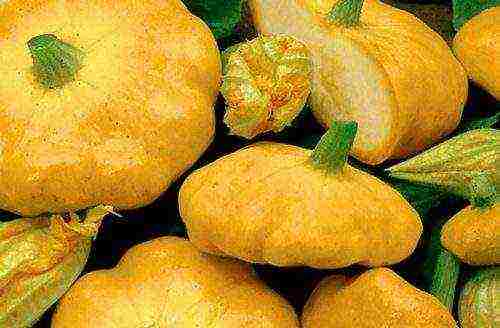
This hybrid has a powerful spreading bush, on which up to 18-20 fruits can grow at the same time. The yield is excellent, while the plant is highly resistant to various diseases.
The fruits of the Sun Bunny are medium-sized, weighing up to 150-200 grams, yellow disc-shaped.There is a slight ribbing along the edge. The pulp is creamy, very firm. The hybrid is intended for canning with whole fruits.
Solar Blast F1
Another squash is a tiny Solar Explosion. It is a mid-early hybrid of squash, has a good yield.
Fruits of a bright yellow hue, in the form of tiny discs, weighing up to 100 grams. The flesh is of a beautiful creamy color, there are very few seeds. This hybrid, like the Sun Bunny, is recommended for conservation.
Penny
Among the novelties of miniature squash, one cannot fail to mention the Kopeyka gherkin. This is a super-early squash, the ripening time of the fruits of which is only 37 days. The plant is a bush type, compact, forms flowers of a predominantly female type.

The variety has a good yield, while being successfully grown in all regions of the country. The fruits are small, orange discs, weighing only 30 grams. The yield is friendly, while the squash does not crack, does not outgrow within two weeks. Used for whole pickles and marinades.
Sunny Delight F1
Lovers of romance are invited to pay attention to the very fruitful hybrid Sunny Delight, which in Dutch means Sunny Charm. The manufacturer is the well-known company Seminis.
This squash has an early ripening period (up to 40 days), is resistant to disease and temperature changes. The plant is a bush type, weak branching, forms squash weighing up to 75-80 grams. The color of the fruit is yellow, the shape is in the form of a disk with a small carved border. Resistant to greening, the pulp is juicy, creamy, very tasty.
It is used for the production of baby food, as well as fresh.
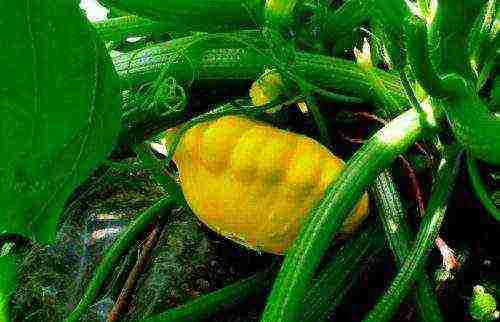
Emeralds in the beds
The next group is squash, the fruits of which are green in color, while the shades can be very different.
Gosh
An interesting variety of squash, the fruits of which are at first painted in a pale green color, and as they ripen, they change to dark green and almost black.
The plant is bushy, vigorous. The first squash ripens about 50-52 days after germination. Fruits in the form of a disc, there is a slight segmentation on the surface. Average weight - no more than 350 grams. The skin is firm, the flesh is white, juicy and crispy. Gosha is a versatile variety, therefore it is suitable for preservation (small fruits) and for various culinary dishes.
Chartreuse F1
One of the most disease resistant is the fruitful Chartreuse hybrid. It is an early hybrid, forms fruits of green color weighing up to 400 grams. Patissons have the appearance of a disc; as they ripen, yellow stripes may appear on the surface. Young fruits with salad pulp are suitable for canning, fresh consumption, and more mature squash are used for processing.
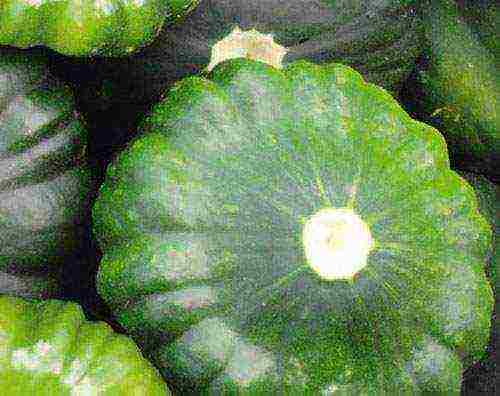
Malachite
Another green-fruited miracle is a variety of squash Malachite. Patisson begins to yield a harvest 45 days after the appearance of the first shoots, it is highly resistant to diseases, cold snaps. Squash Malachite - like small plates, have a border around the edges. Their average weight is 400-500 grams, the skin is of a rich green hue.
The pulp is juicy and very tender, the taste is excellent. Feature of the variety: resistance to drought, so even with irregular watering, the crop will still please.
Watermelon F1
This original squash will delight gardeners not only with good yield, but also with its exotic appearance. Its fruits are small discs, have a variegated color, giving them a resemblance to watermelons.
The hybrid is not afraid of many diseases, ties squash even under adverse conditions. Variegated squash reaches a mass of 300 grams, inside them there is a juicy pulp with an unusual taste for a vegetable and the aroma of fresh forest berries.
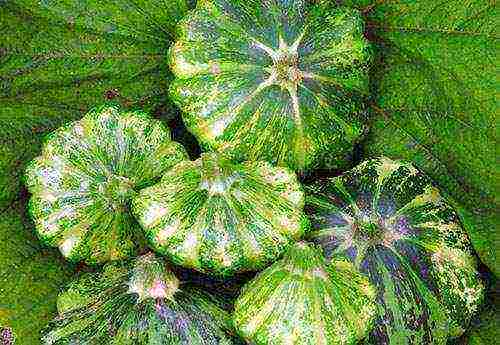
Add some color to the beds
It is impossible to dispense with the review without describing the patissons with an unusual color.This variety deserves attention not only because of its exotic appearance, but also because of its excellent taste and very high yield.
Bingo bongo
On a beautiful small bush of the Bingo-Bongo variety, unusual fruits ripen in July - lilac squash. They have the shape of discs with weak segmentation, reaching a mass of 450-650 grams. They look very colorful on the garden bed, attracting the views of others.
Squash Bingo-Bongo have juicy and tasty pulp, which is not quite typical for these vegetables tenderness. The peculiarity of this squash: unusual color of the fruit, a raised rosette.
Lilac squash are used for conservation; in assorted tomatoes and cucumbers they look festive and very original.
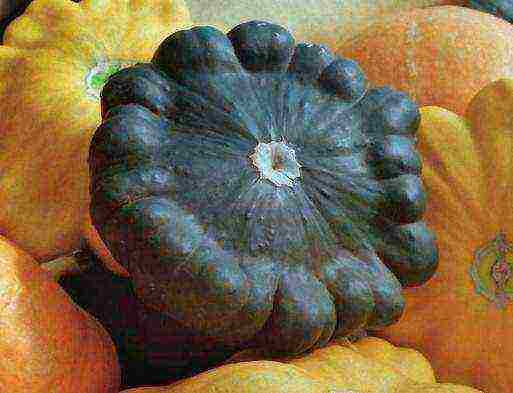
As you can see, gardeners who want to plant squash on the site have a huge selection. The main thing is not to be lazy and to provide the culture with good care, and then the harvest of delicious multi-colored plates and discs will surely delight you!
No related posts.
 Small squash are vegetables that are great both for stewing and frying, and for preparing for the winter. They keep as well as pumpkin. Previously, the varieties of squash had only a white skin and pulp, regular shape with small waves along the edge. Early varieties with orange peel and varied shapes are available today.
Small squash are vegetables that are great both for stewing and frying, and for preparing for the winter. They keep as well as pumpkin. Previously, the varieties of squash had only a white skin and pulp, regular shape with small waves along the edge. Early varieties with orange peel and varied shapes are available today.
Squash varieties are:
- early, which are harvested 40-50 days after the first shoots;
- mid-ripening, yielding in 50-60 days;
- late squash with a harvest of 60-70 days.
Beautiful fruits of different colors are tasty and healthy. Doctors recommend eating this vegetable for those who suffer from hypertension, vascular disease, kidney disease.
Squash: growing (video)
Popular varieties of small squash
Yielding varieties of small squash:
- Variety White 13 - the best for open ground. Pumpkins of this species have a weak division into segments. They taste like zucchini, the flesh is not so sweet, and the skin is shiny. Fruits weigh from 300 g to 500 g. For a full season, almost 4 kg of delicious and healthy squash can be harvested from one bush.
- Another hybrid belonging to the early maturing - Polo F1... Bushes grow compact, young fruits are distinguished by light green skin. After they are ripe, the color turns white. The fruits weigh from 300 to 400 g. The flesh of the squash is very tasty and is suitable both for canning and for preparing various dietary dishes. The variety gives a consistently high yield, it is resistant to many diseases. It can be safely acquired by beginners who do not yet have experience in growing vegetables.
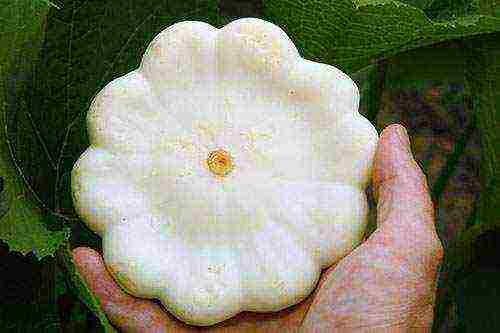
Also read: Characteristics and features of growing Chinese cucumbers
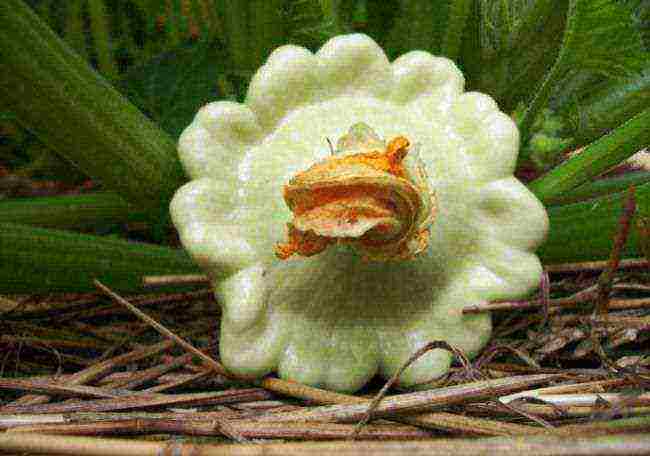
- Hybrid Sunny Bunny F1 refers to early maturing. It has a consistently high yield, up to 20 pumpkins can ripen at the same time on one copy. This variety can also be attributed to mini, the weight of ripe fruits is only 150-200 g. The pulp is dense, tasty, light orange or creamy. The hybrid is resistant to powdery mildew and other diseases.
- Squash hybrid Watermelon F1 looks like a watermelon. The fruit is disc-shaped, which becomes rounder as it ripens. Refers to mid-ripening varieties with ripe fruits weighing up to 450 g.

- Delicacy hybrid Chartreuse F1 has a high yield and early ripening. Ripe fruits are green and dark. Young squash with tasty soft greenish flesh, in mature ones it is much lighter. If the ovaries are up to 3 cm, they are great for use in salads, larger ones are suitable for preparing almost any vegetable dish.
- Gosh - squash with large and strong bushes. The weight of dark green fruits reaches 300 g. When preserved, the dense consistency characteristic of these fruits is preserved. The variety has a consistently high yield and resistance to rot and diseases.
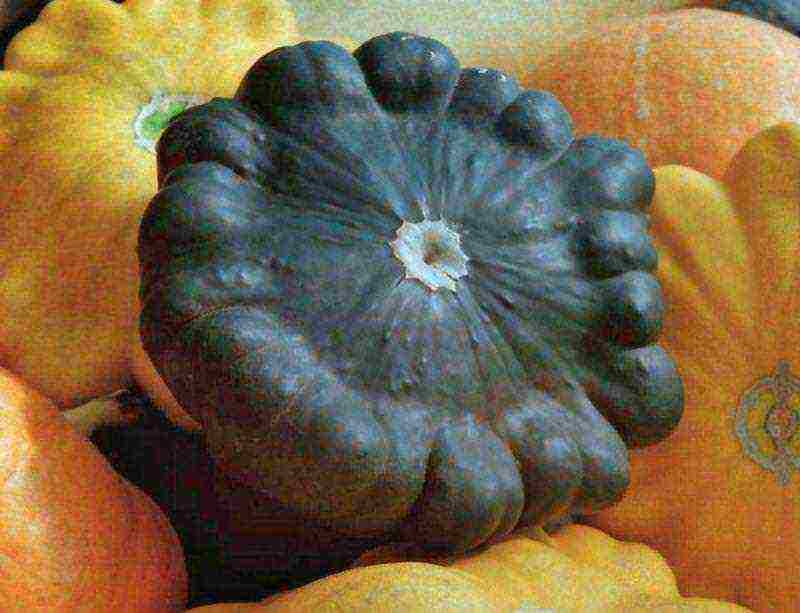
The specifics of sowing small patissons
When sowing, it is best to use seeds that are no more than 3 years old. If the seeds are fresh, they need to be warmed up for several days. In order for them to rise faster, they are soaked in a solution of boric acid for several days, washed with water and dried. When the first leaf appears, 1 plant is left in the hole. If the bushes are too dense, you need to cut off several sheets for good ventilation and access to flowers for bees.

Small fruits up to 7 cm in diameter are harvested for preservation and desserts. For cooking dishes and salads - up to 12 cm.
All the while growing and harvesting, the bushes need to be fed and watered.
The rules for caring for squash are similar to those that apply to zucchini, only the ground around the bushes needs to be loosened more often. Top dressing for plants is applied only 3 times. The first time after the first shoots appeared. The second and third time - after the appearance of the first ovaries. In order to prevent burns on the leaves, they need to be watered with clean water after feeding.
How to preserve squash (video)
You need to harvest the squash regularly, about 2-3 times a week, after they reach the desired diameter of up to 12 cm. Cut the squash together with the stalk and immediately process it. Fruits are suitable for storage after full ripening. Many owners make a common mistake - they do not remove some of the leaves from too dense bushes. Foliage thickening leads to a decrease in yield, as there is no proper ventilation.
Patisson is an excellent vegetable for preparing dietary dishes, it is suitable for everyday and festive menus.
Gallery: squash (25 photos)
Reviews and comments
Did you find a mistake in the text? Please select it and press Ctrl + Enter. Thank you!
Rating:
(
estimates, average:
out of 5)
Squash is an annual thermophilic vegetable crop, successfully grown in central Russia. It has both culinary and decorative value. Their pumpkin fruits look spectacular both on the garden bed and on the table, and are even used in interior decoration. All types of heat treatment are allowed - salting, stewing, pickling. From them you can bake pancakes and use them as baking pots.
For different purposes, different varieties are used, which differ in shape, color, size, ripening time and growing conditions. Each of them has its pluses and minuses, so it is best to choose them based on a specific purpose.
This crop is often mistakenly called dish pumpkin or simply mini pumpkin. In fact, it is an independent species, but it really belongs to the pumpkin family.
The best varieties of white squash
White 13
A popular unpretentious variety with relatively small fruits. It has the best taste in the "weight category" 80-100g. It can grow up to 0.5 kg, but the rind becomes quite tough and the flesh is watery. Differs in high cold resistance, ripens in 65-70 growing days. It takes 6-7 weeks from flowering to harvest. The taste is lightly salted, neutral, the density is average. It can be recommended as the best variety for open ground in mid-latitude conditions. The advantages are good keeping quality, ease of maintenance and high yield.

Umbrella
Semi-bushy early maturing variety with a vegetative period of 40-50 days. It has a dense white flesh and a smooth surface, sometimes with a slight tuberosity. The color is whitish, sometimes with a slight green tint. Bell-like shape with pronounced teeth. The fruits are large enough, with an average weight of 300-400g. Individual specimens can grow over a kilogram in weight. The firm flesh has a slight sweetish flavor. Designed for conservation, extinguishing. The disadvantages are low keeping quality and poor endurance during transportation.
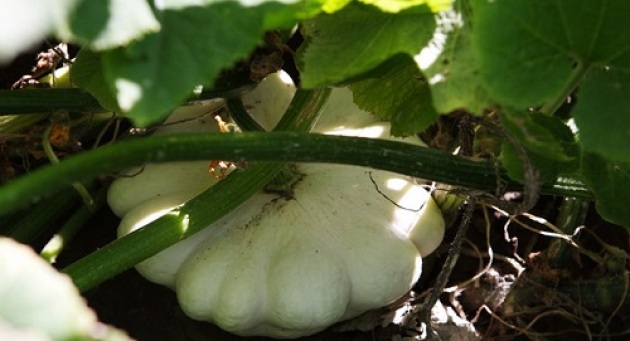
Disk
Refers to early ripening, "pumpkins" weighing up to 400 g can be removed after 40-50 days.They have a disc-like shape, a pronounced segmented surface and a smooth, hard skin. The serration is poorly expressed. Medium-dense pulp, neutral taste, crunchy.
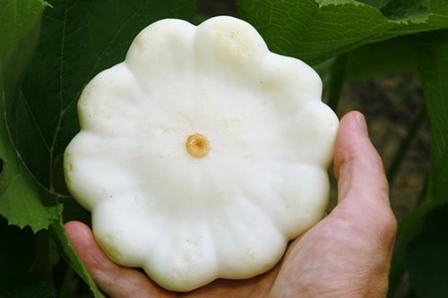
Suitable for daily cooking and preservation. Keeps well fresh.
This variety is more susceptible to powdery mildew than others!
Cheburashka
Differs in high cold resistance and increased branching. Can be grown in northern regions. The first harvest can be removed after 36-40 days, after which, with proper care, it bears fruit for a long time. It has a dish-shaped shape with a slightly wavy edge. Fruit diameter - 9-10 cm. Delicate pulp has excellent taste and high density.
Ufo white
Mid-season (vegetation period 45-55 days), bush. Squash are large, 400-600g (some specimens can reach 1 kg), dish-shaped. But for preservation, they require earlier collection, while the skin is soft and tender. For storage, on the contrary, overripe fruits with a hard skin are suitable. They lie well and are resistant to cold weather.
The best yellow-orange varieties of squash
These varieties are bred on the basis of white varieties, have a yellow-orange color due to the high content of carotene. In addition to excellent taste, they are valuable as an additional source of vitamin A and lutein.
Patissons are often recommended for dietary and medical menus. Especially useful for vascular disorders, anemia, gastrointestinal diseases.
Sun
A high-yielding variety, excellent for canning, with small, uniform, rich orange fruits - no more than 200-300 g. They grow on a compact bush, from which you can collect an average of 15 bright spectacular squash. The pulp is firm, creamy. One of the best varieties in this group, suitable for pickling, stuffing, baking, stewing. Ripening period - 55-65 days. Resistant to powdery mildew.
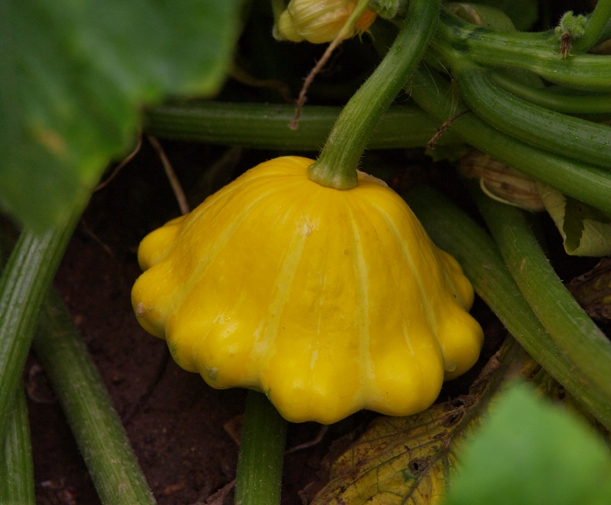
Sunny bunny
Also one of the best small-fruited early maturing varieties. Good for whole canning. Bears fruit amicably and abundantly due to the fact that it forms a predominantly female color. It is unpretentious in leaving. The creamy dense pulp has a rich flavor range.
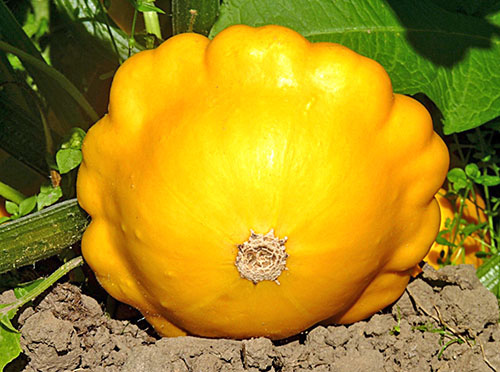
Sunny Delight
An early ripe bush hybrid producing miniature squash, ideal for pickling.

They grow in mass only 60-80g. With the same stated ripening period, they usually yield a crop a week earlier than other small-fruited varieties. It tolerates dry summers well.
For a richer harvest, plant squash after potatoes, radishes, peas, tomatoes, onions, or carrots.
The best green-fruited varieties of squash
Chartorez
A very beautiful small-fruited hybrid with an early yield - the growing season lasts just over a month. Fruits are glossy, deep dark green in color. White or yellow streaks sometimes appear as it ripens. The young, pale green flesh gradually becomes pure white. It has exceptional taste and is suitable for preservation.
Gosh
A hybrid of the professional series. Gives tall, strongly growing bushes and disc-shaped pumpkins of 300-400 g. At first they have a dark green color, which gradually turns into black as it matures. The crispy flesh is very dense, tasty, milky-creamy. It is appreciated for a long yield period and high decorative and taste qualities.
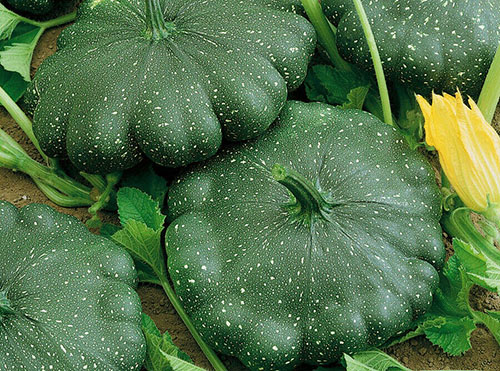
Purple squash
Bingo bingo
Compact bush variety with edible decorative fruits. Under the dark purple rind, a tender and juicy white flesh ripens. May have dark green varieties. Productivity and keeping quality are average, early ripening, about 40 days. It grows up to 500-600 g, but for conservation it is advisable to pluck at a younger age.
This is not the whole list of the best varieties of this spectacular vegetable, in addition, the market is constantly updated with new products.Many of them differ little in care and cultivation, and often in appearance, so it is not difficult to choose a variety according to certain specified characteristics. All the varieties described are suitable for growing in mid-latitude climates, have high taste characteristics, take root quickly, and give a good return. Therefore, it remains only to choose the best for your taste and color.
Video review of growing squash
